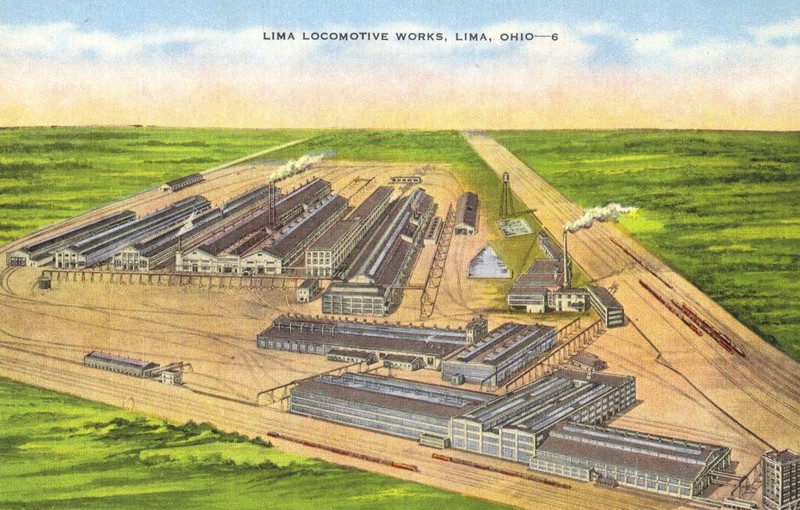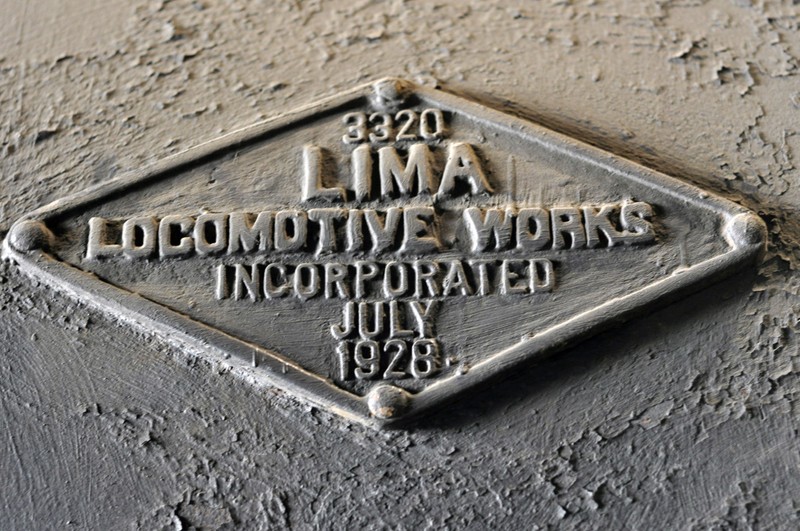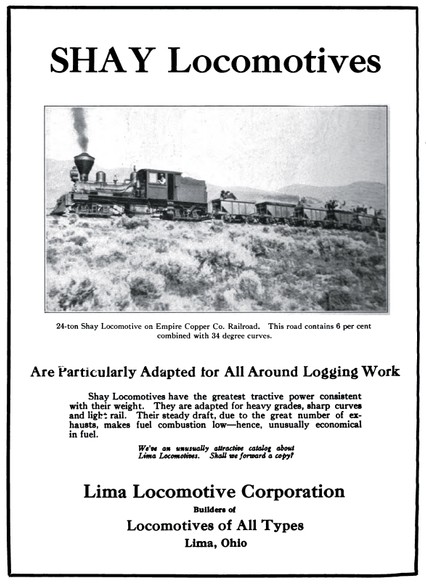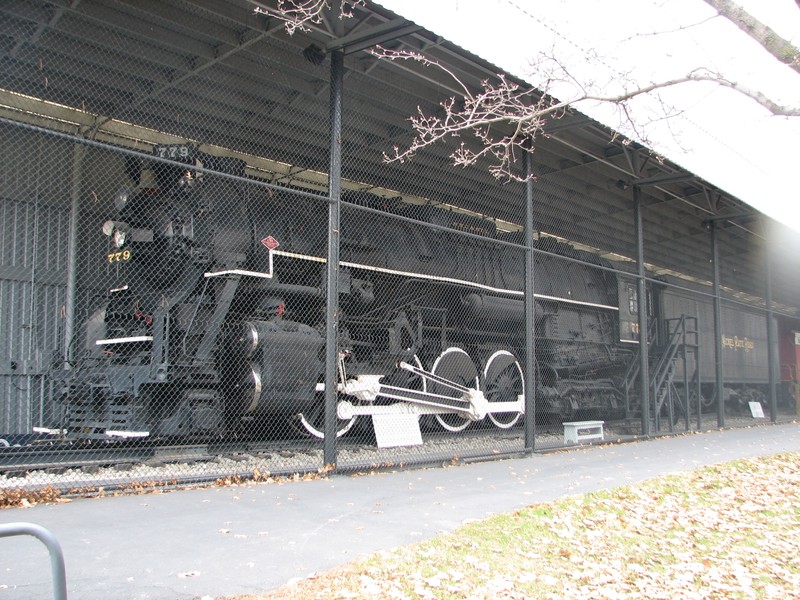Lima Locomotive Works (1869-1981)
Introduction
Text-to-speech Audio
Images
A postcard of the Lima Locomotive Works. The building seen at the bottom right corner of the card was located approximately at the site of the map pin for this entry.

The Lima Locomotive Works builder's plate on Lima #3220, Shay Locomotive #2 at Cass Scenic Railroad State Park

A 1915 advertisement for Shay locomotives manufactured by the Lima Locomotive Works

Ephraim Shay, circa 1890
.jpg)
The "Berkshire-type" Locomotive No. 779, the last steam locomotive manufactured by the Lima Locomotive Works; built in 1949 for the Nickel Plate Road and now on display in Lima's Lincoln Park

Backstory and Context
Text-to-speech Audio
What would eventually become the Lima Locomotive Works originated with a failed agricultural machine company in east downtown Lima. Its factory was purchased in 1869 by five partners. These men—John Carnes, Frederick Agerter, George Harper, George W. Disman, and Jesse M. Coe—founded Carnes, Agerter & Company to build steam engines and various other small machines. It did well, eventually expanding into the manufacture of steam traction engines. In 1876, their business was reorganized as the Lima Machine Works. Two years later, facing continued repercussions from the Panic of 1873, the company began building small steam locomotives, in the hopes of marketing them to its previous saw mill operator customers. This business stayed small (Lima built only six locomotives in 1879), but was moderately successful.
The Lima Machine Works’ commitment to high quality work made a good impression on customers such as Ephraim Shay. Shay was a Michigan lumberman who had built his own locomotive to improve efficiency in his business. Unlike other locomotives of the day, it was designed especially for low speeds, heavy loads, steep grades, and poor-quality wooden rails. Asked by a friend for a locomotive like his, Shay directed him to the Lima Machine Works, saying, “they put more brains in their work than any firm I was acquainted with.”[6] Lima ultimately received exclusive rights to the design under Shay’s 1881 patent and continued to improve it. The Shay locomotive took off in the lumber industry, and it brought the Lima Machine Works along with it. Lima built one to three dozen Shay engines per year throughout the 1880s, then sixty-five in 1890, then, in 1907, an all-time high of 217. It was, for many years, the company’s main product. The Shay ultimately fell into disuse as trucks took up a larger and larger share of the lumber transport market. Lima introduced a vastly improved model, the Pacific Coast Shay, in 1927, but it barely sold. The last regular-production Shay rolled out of the factory in 1937, and one final special order was completed in 1945.
As a result of the Shay’s success, the Lima Machine Works expanded rapidly. It invested in the Lafayette Car Works, located in south Lima, and began experimenting with the manufacture of freight cars. The company was reorganized as The Lima Locomotive and Machine Company in 1892, and the following year it purchased Lafayette’s south Lima plant. However, development of this facility was stalled by a destructive fire and the Panic of 1893.
In 1900, Lima was still only building small industrial locomotives. Its new manager, A. L. White, was determined to change that. He resumed construction of a factory in south Lima in 1902, and the company eventually moved all of its operations here. In 1910-12, Lima expanded the south Lima plant, tearing down old buildings and constructing a new, two-million-dollar factory. The company was reorganized yet again in 1912 as the Lima Locomotive Corporation, and, the next year, it manufactured its first large locomotives. The business seemed to succeed but was, in fact, struggling financially, largely due to White’s overinvestment in other ventures. In 1916, Lima fell into a crisis; it was quickly bought by New York interests under Joel S. Coffin and Samuel G. Allen and reorganized as the Lima Locomotive Works. Now, offices and company leadership were all located in New York. Coffin and Allen also undertook significant new hiring, most prominently choosing William E. Woodard as the Vice President of Engineering.
Woodard was an up-and-coming leader in locomotive design who, luckily for Lima, was in the right place at the right time. The post-World War I years saw rising demand for a more powerful and more efficient freight engine. Woodard’s first major improved model, completed in June 1922, was a heavy 2-8-2 engine known as the N.Y.C. 8000. It was still a generally standard design, but he improved many varied, smaller aspects and installed an adapted booster engine. As a result, the 8000 offered seventeen percent more power with only two percent more weight compared to a similar Mikado locomotive. Three years later, Woodard would complete his greatest work: the Class A-1, also known as the “Berkshire,” the father of the “Super Powers.” This model introduced the 2-8-4 wheel arrangement, with a four-wheel truck under the firebox. It was the most powerful and efficient steam locomotive to date, with countless other minor improvements. The A-1 was also far superior to the solutions being explored by Baldwin and Alco, Lima’s two competitors. (While Lima had a strong hold as number three in the locomotive market, it would still never surpass either of those two companies, which regularly produced five times as many engines per year.) Lima ultimately built over 360 Super Power-type locomotives.
Lima Locomotive Works underwent a final large expansion in 1918-22. It managed to survive the Great Depression, in small part as a result of its purchase of the Ohio Power Shovel Company in 1928. During World War II, demand for both civilian and military locomotives, as well as other military equipment, skyrocketed; Lima employed 3,459 people, the highest number in its history, in 1944. It manufactured over one thousand military locomotives. Lima was also contracted to build tanks, specifically the M4A1 Sherman. The company built the first Sherman tank in February 1942, and it manufactured over fifteen hundred M4A1s by September 1943.
After the war, the locomotive industry began to quickly shift to diesel-electric engines. However, Lima held firm to its status as steam’s chief innovator, practically refusing to convert to diesel. In 1947, in a last-ditch attempt to save the company, it merged with the General Machinery Company of Hamilton, Ohio, to become the Lima-Hamilton Corporation. Lima used Hamilton’s diesel engine design (what would turn out to be a relatively poor-quality model) in a paltry 174 switchers between 1949 and 1951. In 1949, Lima completed its last steam engine; the next year, it was purchased by Baldwin Locomotive Works to create the Baldwin-Lima-Hamilton Corporation. BLH ended locomotive manufacture at the Lima plant on September 11th, 1951, turning it completely over to the manufacture of construction equipment. This ended Lima’s run of 7,752 locomotives, including 4,787 “regular” steam engines, 2,761 Shays, 174 diesel-electrics, and thirty electric shells, as well as some tenders and four steam-powered rotary snow plows. Armour & Company bought BLH in 1965 and sold its Construction Equipment Division to the Clark Equipment Company in 1971, who transferred the Lima plant to its own Crane Division in 1978. The Crane Division, including the Lima plant, was shut down in 1981. The Lima factory sat idle until 1998, when it was demolished.
Sources
1) Barris, Wes. Steam Locomotive Builders: Lima Locomotive Works, Steam Locomotive dot Com. Accessed July 29th 2020. https://www.steamlocomotive.com/builders/#lima.
2) Edson, William D. White, John H. Lima Locomotive Works. The Railway and Locomotive Historical Society Bulletin, no. 123. pp. 81 - 102. Published October 1970. JSTOR. https://www.jstor.org/stable/43518352.
3) Fischer, William, Jr. Lima Locomotive Works, HMdb.org. June 16th 2016. Accessed July 29th 2020. https://www.hmdb.org/m.asp?m=22935.
4) Fischer, William, Jr. NKP Berkshire Locomotive No. 779, HMdb.org. January 20th 2020. Accessed July 29th 2020. https://www.hmdb.org/m.asp?m=29715.
5) Jackson, David D. Lima Locomotive Works in World War Two, The American Automobile Industry in World War Two. October 29th 2019. Accessed July 29th 2020. http://usautoindustryworldwartwo.com/limalocomotiveworks.htm.
6) Lima Locomotive Works. Internet Archive Wayback Machine. March 4th 2018. Accessed July 29th 2020. https://web.archive.org/web/20180304211544/http://limalocomotiveworks.com/.
7) Lima Locomotive Works, Ohio History Central. Accessed July 29th 2020. https://ohiohistorycentral.org/w/Lima_Locomotive_Works.
8) Marre, Louis A. Lima: Too Little, Too Late, Railfan. Winter 1974. Railfan & Railroad Magazine. March 1st 2016. Accessed July 29th 2020. http://railfan.com/lima-too-little-too-late/.
Wikimedia Commons (https://commons.wikimedia.org/wiki/File:Lima_Locomotive_Works_postcard.jpg) - Public Domain
By Jarek Tuszyński on Wikimedia Commons (https://commons.wikimedia.org/wiki/File:Cass_Scenic_Railroad_State_Park_-_Shay_2_-_01.jpg) - CC BY 4.0 (https://creativecommons.org/licenses/by/4.0/deed.en)
Originally in Locomotive World vol. 8 no. 3: July 1915 - on Wikimedia Commons (https://commons.wikimedia.org/wiki/File:Lima_Locomotive_Shay_advert_July_1915.jpg) - Public Domain
On Wikimedia Commons (https://commons.wikimedia.org/wiki/File:Ephraim_Shay_(c_1890).jpeg) - Public Domain
By Sclark1000 on Wikimedia Commons (https://commons.wikimedia.org/wiki/File:Baldwin_Berkshire-type_No._780_built_for_the_Nickel_Plate.jpg) - CC BY-SA 4.0 (https://creativecommons.org/licenses/by-sa/4.0/deed.en)
